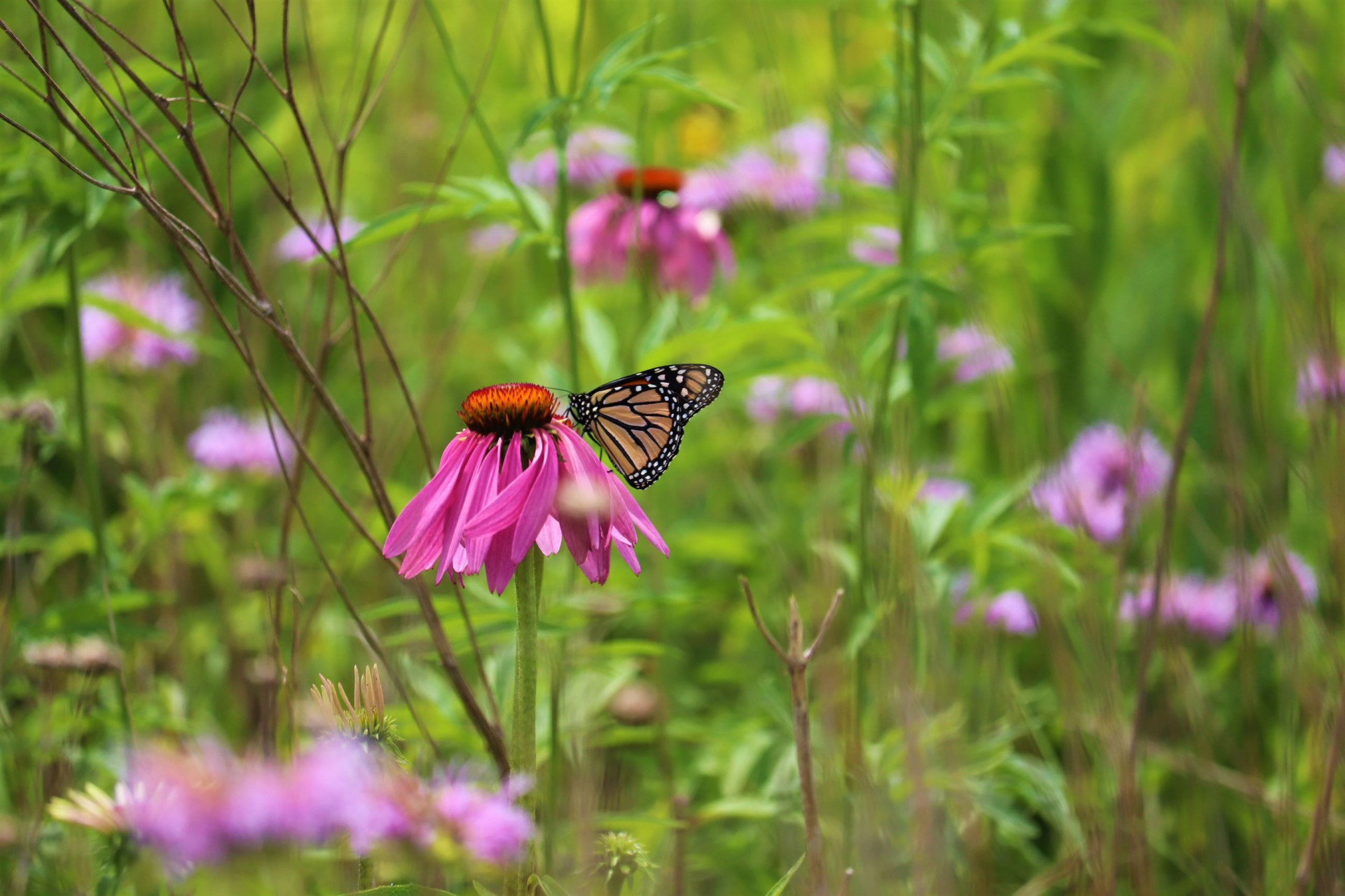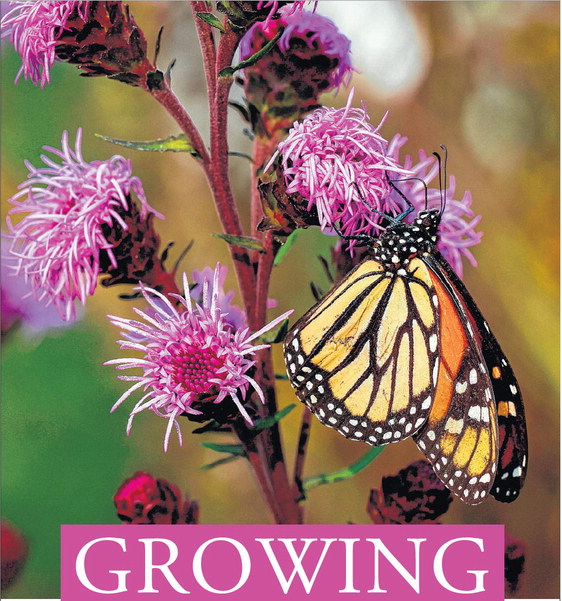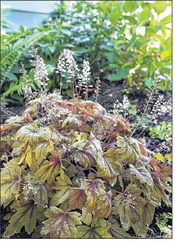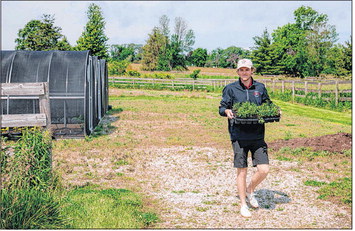
Growing Native Plants
May 12, 2025
The excitement and enthusiasm for growing native plants in Linn County begins to rise as more people are purchasing plants native to their region, and buying plants that are beneficial to native bees, butterflies and birds.

The following article was published in the Cedar Rapids Gazette on Sunday, May 11, 2025. Reprinted here with permission.
Growing Native
More gardeners interested in plants that help boost ecosystem
By Bailey Cichon, The Gazette
A 2023 survey commissioned by the National Wildlife Federation, in partnership with the National Gardening Association, found that 17 percent of adults in the U.S. are purchasing plants native to their region. Similarly, 28 percent are buying plants that are beneficial to native bees, butterflies and birds.
Augie Bergstrom, research station manager for the nonprofit Monarch Research Project in Marion, has witnessed the growing excitement for native plants in Linn County. The nonprofit’s second Orange Alert event, which features panels of experts talking about supporting monarch butterflies through backyard gardens, sold out its 400 seats weeks early.
“Obviously, (native plants) helping the ecosystem is a huge benefit, but they also have this huge beautification factor that people hadn’t really been thinking about, and I think people are more now,” Bergstrom said.
“I go out, and when I speak with folks, they’re really interested in getting seed, wanting to know where they can buy plugs from,” he added.
The attention toward wildlife in planting habits is needed. Just 0.1 percent of the 23.3 million acres of prairies surveyed in Iowa’s original public land survey in the 1850s remain. Plus, between the years 2000 and 2020, butterfly abundance dropped by 22 percent across about 554 species, The Gazette previously reported.
Wayne Thogmartin, a research ecologist with the U.S.
Geological Survey involved in the butterfly abundance study, said that the decline of butterflies and other pollinators could lead to human health risks down the line.
“I think that this is just a symptom of a larger concern about how we’re failing to take care of the natural world around us,” Thogmartin previously told The Gazette.
“It’s gonna come back to bite us.”
Native plants are those that were not introduced to a region by humans. Instead, they have grown and evolved over time, providing habitat and food to wildlife. Some examples of plants native to Eastern Iowa are the hairy purple Western ironweed and the dainty prairie phlox.
“They’re very well adapted to the wonky winters and springs in Iowa,” Angel Burns, a Linn County Master Gardener, said of plant species native to the Hawkeye State. “They know how to cooperate with our monarch butterflies and all the other critters that come through.”


ABOVE: A variety of coral bells, or Heuchera, grow in Linda Lockridge’s home garden in Iowa City on June 6, 2017. (The Gazette) TOP: A monarch butterfly forages on an ironweed flower in the native lawn of Karen Rawson’s home last fall in southeast Cedar Rapids. (Jim Slosiarek/The Gazette)
Plants/‘ Do your research’
You don’t need a large yard to make a difference, Burns said. Potted plants can provide the same vital food source to pollinators as a plot in a yard.
Some native plants, like milkweed, are host plants.
“It’s the only thing the female butterfly will lay eggs on. It’s the only thing that the caterpillar itself will eat to reach that chrysalis and eventually butterfly stage,” Bergstrom said.
“If you’ve got critters eating your (plants), you’re doing something right in your garden,” Burns said. “Having host plants for butterflies at that larval stage and the nectar plants, it’s really just helping our whole native ecosystem hopefully rebound and maintain.”
WHY SOME CONVERT GRASS TO NATIVE PLANTS
Kentucky Bluegrass is not native to the United States. According to Oregon State University, traders and settlers brought the grass from Europe.
“Kentucky Bluegrass is a plant that has very little ecological value. So essentially, you’re creating a wasteland for your insects and other critters, birds, (it) trickles down the whole ecosystem,” Bergstrom said.
Bergstrom urged Iowans to consider removing a section of lawn and installing native plants.
“It’s also a place you wouldn’t have to take care of as much if you put a section of prairie in. You’re mowing less, you don’t need a sprinkler system, so in the long run, it’s easier too.”
DO NON-NATIVE PLANTS HELP POLLINATORS?
“A plant that provides pollen and nectar is better than no plant at all,” Burns said. “I still have Cosmos that grow in our front yard. The bees absolutely love it … There’s absolutely nothing wrong with incorporating those things.”
As you design your flower garden, consider creating a bee buffet that has plants that bloom in spring, summer and fall, Burns said.
She gave the example of Eastern redbud trees for spring blooms, rattlesnake master for summer flowers and asters in the fall.
“Just get out there and get your hands dirty … Whether that is through native plants or annual plants that provide that nectar for our pollinator friends,” Burns said.
“Anything is helpful.
Anybody can make an impact.”
One thing to be mindful of is non-native species invading gardens and areas where native plants grow.
“Like Scilla, it’s not a native plant. (It’s) beautiful. People love it. It blooms early, but it will spread and it will take over,” Burns said.
“Do your research, be a little more cognizant of what you’re planting.”
HOW TO FIND NATIVE PLANTS IN IOWA
When you walk into a plant nursery or garden center, you’ll likely find a lot of cultivars, or plants that have been selectively bred to favor specific traits, like height or color.
If a native plant has been cultivated, it is called a nativar.
“A lot of them have been bred for different shapes or colors and to be pollen or nectar free,” Burns said. “I know sunflowers, for a while they were really pushing that some of those not have pollen just because people don’t want it on stuff.”
Nativars might be sterile, meaning they won’t produce the seeds that birds snack on in the winter.
To identify whether a plant is a true native or a nativar, take a careful look at the tag on the plant you are looking to purchase.
Take Heuchera, for example. You might know this popular low-growing, shade-loving plant by the name Coral Bells or Alum Root. It’s a great native substitute for the colorful Coleus plants that are native to Southeast Asia and Indonesia.
Heuchera richardsonii is native to Iowa, but Heuchera is prized by gardeners for its rainbow of cultivars, like Heuchera “Grape Timeless” or Heuchera “Obsidian.”
When you encounter a plant with quotation marks in its name, you are looking at a cultivar.
If you’re seeking out plants native to Iowa, you may want to double check plants that are marketed as “native.”
They may be native to North America, but not necessarily the state of Iowa.
“Go encourage your local nurseries to carry more natives. That’s a huge hole in what we’re trying to do as a community … You can get seed locally oftentimes, but it’s hard to get native plugs, and I think some of these nurseries are getting better, but we need the public to push for what they want,” Bergstrom said.
Looking for seed?
Monarch Research Project has over 30 species of prairie plant seeds, including three types of milkweed, available for free. Call Bergstrom at (319) 538-1835 to set up an appointment.
Comments: bailey.cichon@thegazette.com

Augie Bergstrom carries milkweed plants used to feed caterpillars last June at the Monarch Research Station in Linn County. Bergstrom urges Iowans to consider removing a section of lawn and installing native plants. (Nick Rohlman/The Gazette)